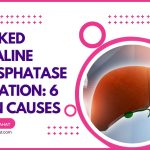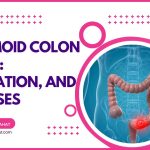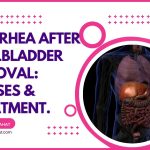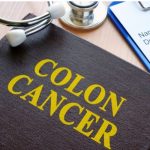5 Causes of Stomach & Shoulder pain (Right Side): Gastroenterologist Explains
Our content is not intended nor recommended as a substitute for medical advice by your doctor. Use for informational purposes only.
The most common cause of right side stomach and shoulder pain is gallbladder problems such as gallstones. Other causes include liver pain, right colon pain, right pleura and lung disease, etc.
You’re right if you have unexplained stomach and shoulder pain on the right side.
Key insights about right-sided abdominal and right shoulder pain.
- Organs lying on the right side of your abdomen and chest are the most likely cause of combined stomach and right shoulder pain.
- The gallbladder, liver, right colon, right abdominal tumors, right lung, and right pleura are possible sources of the pain.
- Gallbladder diseases (mainly gallstones) are the most common cause of right stomach pain that radiates to the right shoulder.
- Biliary colic occurs as episodes (each about one to 4 hours) of acute onset severe pain in the right side of the stomach radiating to pain.
- The pain often occurs after fatty meals and is associated with nausea or vomiting.
- Referred pain to the shoulder often doesn’t worsen by moving your shoulder.
- Consider local causes of right shoulder pain if the pain significantly increases each time you move your shoulder joint.
1. Gallbladder pain (the most common cause of right side stomach and shoulder pain).
In the majority of cases, gallbladder diseases and conditions are the cause of right-sided upper stomach pain and shoulder pain.
The pain from the gallbladder often affects the upper right quadrant of your abdomen. The pain also radiates to the right shoulder during the attack.
Causes & risk factors:
Causes of gallbladder-related pain include:
- Gallstones (biliary colic) are the commonest cause.
- Acute cholecystitis (acute inflammation and infection of the gallbladder, often as a complication of gallstones).
- Acute cholangitis (infection and inflammation of the bile ducts, often due to obstruction by a stone or tumor).
- Sphincter of Oddi dysfunction: failure of relaxation of the sphincter at the end of the common bile duct leads to biliary-like pain.
The presence of one or more gallstones inside your gallbladder is the most common cause of gallbladder pain. 10% to 15% of adults have gallstones (reference).
Who are at higher risk (predictors of gallstones):
- Females.
- Obese people.
- Older ages (40 or more).
- Native American, Hispanic, or Mexican races.
- Sedentary lifestyle.
- Pregnancy.
- Dieting (rapid weight loss).
- Eating a high-fat diet.
- Estrogen-containing medications such as oral contraceptives and hormone therapy.
- Chronic hemolytic anemias such as thalassemia
Symptoms of gallbladder pain:
The simple (uncomplicated) gallstones cause intermittent attacks of biliary colics. Sometimes, gallstones obstruct the neck of the gallbladder leading to acute cholecystitis.
The symptoms and differences between uncomplicated and complicated gallbladder pain are in the table below (reference).
Typical (uncomplicated) gallbladder pain | Acute cholecystitis & its complications | |
| 1. Site | Usually, The right upper quadrant of your abdomen (right stomach pain). | The same. |
| 2. Spread | – The pain may spread to the back of the right shoulder. – Also, it spreads to the epigastric area. | The same. |
| 3. Character | Constant. Builds up and then disappears gradually. | The same, but more severe and more prolonged. |
| 4. Duration | At least 30 minutes. It may last up to 6 hours. | It can last more than 6 hours. |
| 5. Relation to food | – Triggered by foods (especially fatty food and large meals. – However, it can start spontaneously. | Often persistent. Regardless of eating. |
| 6. Comes and goes? | Yes | No |
| 7. Nausea, vomiting. | Often Present. | Present, but very severe and persistent. |
| 8. Associated symptoms | – Heartburn and chest pain. – Bloating, fullness. – Early satiety. – Epigastric pain. | The same, but more severe. |
| 9. Fever. | Absent. | – Often present. – it is more frequent and severe in complicated cholecystitis |
| 10. Jaundice | Absent | Present if there are Bile duct stones. |
| 11. Murphy’s sign (tenderness over the gallbladder area) | Often absent. | – Often present in uncomplicated acute cholecystitis. – It may be absent in complicated (gangrene or perforation) cholecystitis. |
2. Liver pain
Causes:
- Acute inflammations of the liver (acute hepatitis).
- Liver congestion (often due to congestive heart failure or chronic chest diseases).
- Liver abscess or cysts.
- Liver tumors (benign or malignant).
- Portal vein thrombosis.
- Budd-Chiari
- Perihepatitis (Fitz-Hugh-Curts) syndromes.
- Chronic liver diseases such as fatty liver disease, chronic hepatitis, and liver cirrhosis RARELY cause liver pain.
Symptoms of liver pain:
Liver pain locations include (see the diagram).
- The right upper quadrant of the abdomen: is the most common site.
- The lower right rib cage.
- The right shoulder (referred pain).
- The mid-back area is to the right.
The liver pain is often felt in the left upper quadrant (same as the biliary colics). However, liver pain is different in many aspects.
The table below illustrates the differences between biliary colics and liver pain.
Description. | Biliary colics | Liver pain |
1. Location. | Usually, The right upper quadrant of your abdomen. | Usually in the right upper quadrant (more diffuse than biliary colic). |
2. Spread | – The pain may spread to the back of the right shoulder. – Also, it spreads to the epigastric area. | – The right side of the rib cage. – The right shoulder. – The right mid-back. |
3. Character | – In the form of attacks, it constantly builds up and disappears gradually. | – Constant dull ache, often less intense than the biliary colic. – May be sharp in severe cases such as malignancy. – Maybe throbbing (pulsating) pain. |
4. Duration | At least 30 minutes. It may last up to 6 hours. | Prolonged for days, weeks, or months. |
5. Related to | – Triggered by foods (especially fatty food and large meals. – However, it can start spontaneously. | – The pain is continuous and not related to food. – Pressing on the liver area or moving may exacerbate the pain. |
6. NOT related to: | Movement, bowel movements, or the passage of flatus. | – Not related to food, bowel movement, nor the passage of flatus. |
7. Nausea | Often Present, severe. | May or may not be present. |
8- Commonly associated symptoms | Vomiting, sweating during the attack, and nausea. | There are jaundice, dark urine, swollen lower limbs, swollen abdomen (ascites), coma, and weight loss. |
3. Intra-abdominal inflammatory conditions.
Many intraabdominal inflammatory conditions, infections, and others can cause right abdominal pain referred to the right shoulder.
Infections and inflammatory conditions in the right upper abdomen may irritate the diaphragm and cause severe right stomach and shoulder pain.
Common causes include (reference):
- A right subphrenic abscess (abscess under the diaphragm.
- Atypical (subhepatic) appendicitis is rare appendicitis where the inflamed appendix is found just below the liver (not in the right lower abdomen).
- Perforated viscus on the right side of the abdomen (for example, perforated right colon).
- Severe ulcerative colitis on the right side.
- Complicated right kidney conditions include trauma, pyelonephritis, kidney tumor, etc.
- Intraabdominal sepsis (peritonitis).
- Severe right-sided colon diverticulitis.
- Ruptured ectopic pregnancy.
- Severe gastritis or reflux disease.
Symptoms:
The symptoms often depend on the cause. However, most of these inflammatory conditions cause severe symptoms such as:
- Severe persistent abdominal pain (diffuse or limited to the right side of the stomach).
- Severe tenderness over the abdomen and severe pain on touching or pressing the abdomen.
- Fever.
- Nausea and vomiting (severe).
- Pain when you move, bend your legs, or breath.
- Sings of sepsis include pallor, shortness of breath, fast heartbeats, etc.
4. Intra-abdominal tumors.
Some intraabdominal tumors may cause stomach and right shoulder pain.
Common examples include:
- Right ovarian cancer.
- Right colon cancer.
- Liver cancer.
- Gallbladder cancer.
- Liver metastasis.
- Right kidney and suprarenal cancers.
5. The right pleura and the right lung.
Diseases affecting the right pleura and the lower right lung may result in right shoulder pain with stomach and/or chest pain on the right side.
The pleura is a thin, double-layered membrane that envelopes your lung. Most pleural diseases are painful and may cause right stomach, chest, and shoulder pain.
Common causes include:
- Right pleurisy: inflammation of the right pleura due to infection, kidney failure, trauma, bleeding, etc.
- Pleural cancer: Many cancers may affect the pleura, such as mesothelioma, lymphomas, and metastatic cancer.
- Abscess on the lower right lung.
- Right lung pneumonia.
- Right lung cancer.
In such cases, the patients often have respiratory and chest symptoms together with stomach and shoulder pain on the right:
- Chest pain on the right side.
- The pain often becomes exacerbated with respiration.
- Shortness of breath.
- Cough.
- Expectoration.
- Fever.
- Purulent (often yellowish) mucus).
6. Others.
Other causes of right stomach and right shoulder pain include:
A. Laparoscopic surgery:
During the laparoscopic operation (such as laparoscopic cholecystectomy and appendectomy), your surgeon fills your abdominal cavity with carbon dioxide gas.
The gas inside your abdomen may irritate the nerves responsible for pain sensations.
After the laparoscopy, up to two-thirds of people may suffer stomach pain that may refer to the right shoulder.
Most patients experience shoulder pain on the second day of surgery and rarely during the same day (reference).
B. Phrenic nerve affection.
The phrenic nerve supplies the diaphragm (a wide, thin, and sheet-like muscle that separates your abdominal organs from chest organs).
Irritation, inflammation, or compression of the phrenic nerve may cause right shoulder pain and, sometimes, stomach pain.
C. Muscle conditions.
Trauma, muscle strains, strenuous workouts, and some rare muscle disease (such as polymyositis) may cause right shoulder pain and stomach pain.
D. Fibromyalgia.
Fibromyalgia is a chronic condition of unclear cause. The disease causes long-term, widespread pain all over the body.
Patients with fibromyalgia often have increased pain sensitivity, chronic fatigue, muscle stiffness, sleep disturbances, and chronic headaches.
Also, many patients with fibromyalgia have symptoms typical for irritable bowel syndrome (IBS), such as recurrent abdominal colics, bloating, constipation, or diarrhea.
E. Others:
Other less frequent causes of right stomach and shoulder pain include Familial Mediterranean Fever (FMF), hysterical (malingering), painful skin diseases such as Herpes skin infection, drug side effects, etc.
- Evidence-based
- Written by a doctor.






